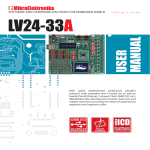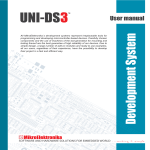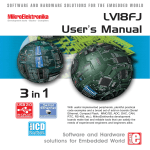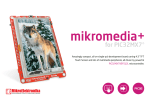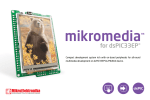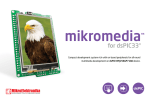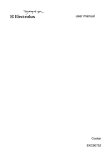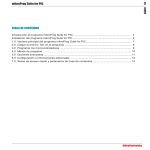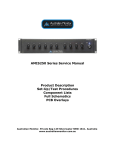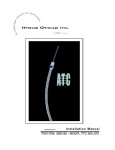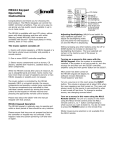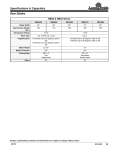Download LV-24-33 Manual - MikroElektronika
Transcript
SOFTWARE AND HARDWARE SOLUTIONS FOR THE EMBEDDED WORLD LV 24-33 User’s Manual MikroElektronika Development tools - Books - Compilers mikro 3 in 1 USB 2.0 DEBUGGER IN-CIRCUIT ICD IN-CIRCUIT PROGRAMMER MICROCHIP 24/33 DEVELOPMENT BOARD With useful implemented peripherals, plentiful practical code examples and a broad set of additional add-on boards (Serial Ethernet, Compact Flash, MMC/SD, ADC, DAC, CAN, RTC, RS-485, etc.), MikroElektronika development boards make fast and reliable tools that can satisfy the needs of experienced engineers and beginners alike. Software and Hardware solutions for Embedded World LV 24-33 KEY FEATURES 1. External power supply from 8 to 16 V AC/DC. 2. Choose between external and USB power supply. When powering from your PC’s USB port, you don’t need an external supply. 3. Very fast and flexible USB programmer on board. The key feature is expandability. By downloading new software, you will be able to program new MCUs in coming years. 4. DS1820 temperature sensor allows you to measure temperature with 0.5°C accuracy. 5. Two RS232 communication ports RS232-A and RS232-B. 6. For presentation purposes, all PORTB pins are connected to, and can be used for measuring voltages set by, the potentiometers P1, P2, P3 and P4. 7. MMC/SD slot for multimedia cards with up to 2GB storage space. 8. Setting the jumper to the upper position sets the pins of the appropriate port to logical one (pull-up). If the jumper is set to the lower postion, pins are set to logical zero (pull-down). It is very important to select pull-up for a port if you expect logical zero on its inputs and vice versa. 9. You can connect an LCD if you need it for your application in 4-bit mode. 10. You can connect a Graphic LCD if you need it for your application or LCD in 8-bit mode. 11. LV 24-33 supports 80-pin and 100-pin PIC24 and dsPIC33 microcontrollers. 12. 85 buttons allow you to control every pin on your microcontroller. 13. You can choose how pressing the button will affect the pin, high state or low state. 14. See all the signals - each pin has an LED. 15. Set LCD contrast according to your display characteristics. 16. All switches on SW2 and SW3 turns ON or OFF the LEDs on all PIC24 or dsPIC33 ports. You can choose which port you want LEDs to be connected to. In certain applications, it is important to remove all unnecessary connections from pins. These DIP switches let you disconnect all LEDs from MCU pins. 17. On-Board peripherals are connected to the microcontroller using SW1. MMC/SD Card is connected to the microcontroller through the switches 5, 6, 7 and 8. Both RS232 communication ports are connected to MCU using first four switches on SW1. 18. PORTB is connected to a resistor network, using switches SW4 and SW5. If a switch is in OFF position, the appropriate pin has either pull-up or pull-down resistor attached. This is very important as it enables PORTB to be used in analog mode as an A/D converter as well as an ordinary digital I/O port. 19. ICD2 (In-Circuit Debugger) connector. 20. Reset circuit - if the reset button is pressed a hardware reset will take place (MCU will start executing from the beginning). CONTENTS LV 24-33 User’s Manual MikroElektronika Development tools CONTENTS LV 24-33 with USB 2.0 PROGRAMMER CONNECTING THE SYSTEM page 4 INTRODUCTION page 5 DESCRIPTION OF THE DEVELOPMENT SYSTEM page 6 Switches and their functions page 6 Jumpers page 7 MCU sockets page 8 Power Supply page 11 On-Board USB 2.0 programmer page 12 LEDs page 13 Pushbutton switches page 15 Graphic LCD page 18 LCD 2x16 in 4-bit mode page 20 LCD 2x16 in 8-bit mode page 21 RS-232 Communication page 23 DS1820 Digital Thermometer page 26 A/D Converter input page 27 Direct port access page 29 ICD2 (In-Circuit Debugger) connector page 31 MMC/SD (Multimedia Card) page 32 page MIKROELEKTRONIKA SOFTWARE AND HARDWARE SOLUTIONS FOR THE EMBEDDED WORLD 3 CONNECTING THE SYSTEM LV 24-33 User’s Manual MikroElektronika Development tools CONNECTING THE SYSTEM The development system box contains the development system, product CD, USB cable, RS232 cable and this manual. Step no.1 The first thing to do is to take the system out of the box. Unpack the USB cable and connect it to the PC. Please use USB ports on the back of the PC with direct connection to the motherboard. Step no.2 Install the LvPICFlash programmer and drivers. Start the installation from the product CD: CD_Drive:/product/zip/LvPICFlash_setup.exe. Step no.3 After the installation connect the USB cable to the LV 24-33 board. You will be asked for the LvPICFlash drivers. Point to them in order to finish the driver installation. They are placed in folder: System_Drive:\Program Files\Mikroelektronika\LVPICFLASH\Driver.NT Step no.4 Run and use LvPICFlash as it is explained in the PDF document ‘LvPICFlash programmer’: CD_Drive:/product/pdf/lvpicflash_manual.pdf After these 4 steps, your LV 24-33 is installed and ready for use. You can try to read a program from the chip or to load an example from the examples folder of mikroElektronika’s compilers for dsPIC or from the product CD: CD_Drive:/product/zip/lv24_33_examples.zip. page 4 MIKROELEKTRONIKA SOFTWARE AND HARDWARE SOLUTIONS FOR THE EMBEDDED WORLD LV 24-33 with USB 2.0 PROGRAMMER MICROCHIP 24/33 DEVELOPMENT BOARD INTRODUCTION The LV 24-33 development system is a full-featured development board for Microchip PIC24 and dsPIC33 microcontrollers. It has been designed to allow students and engineers to easily exercise and explore the capabilities of PIC24 and dsPIC33 microcontrollers. It allows PIC24 and dsPIC33 microcontrollers to be interfaced with external circuits and a broad range of peripheral devices, allowing a user to concentrate on software development. Figure 1 illustrates the development board. Each component is marked on a silkscreen, both top and bottom. These marks describe connections to the microcontroller, operation modes, and provide some useful notes. The need for additional schematics is minimized since all relevant information is printed on the board. Figure 1. LV 24-33 with USB 2.0 PROGRAMMER LV 24-33 development board page MIKROELEKTRONIKA SOFTWARE AND HARDWARE SOLUTIONS FOR THE EMBEDDED WORLD 5 INTRODUCTION LV 24-33 User’s Manual MikroElektronika Development tools SWITCHES LV 24-33 User’s Manual MikroElektronika Development tools SWITCHES The LV 24-33 development board features a number of peripherial devices. In order to enable these devices before programming, you need to check if appropriate jumpers or switches have been properly set. Switches are devices that have two positions - ON and OFF, which have a role to establish or break a connection between two contacts. The LV 24-33 development board has four groups of switches. The switches on SW1 are used to enable connection between the microcontroller pins and both RS232 communication devices. The first two switches are used for RS232 A communication lines, while the second two are used for RS232 B communication lines. Switch SW1 is also used to enable SPI communication and to enable connection between the microcontroller pin and CS pin for MMC/SD Card. The switches on SW2 and SW3 are used to enable LEDs connected to PORTA, PORTB, PORTC, PORTD, PORTE, PORTF and PORTG. The switches on SW4 and SW5 are used to enable a connection between the microcontroller PORTB with external pull-up/down resistors. When PORTB pins are used as digital inputs/outputs, the appropriate pull-up/down resistors should be enabled. ON Group of 8 switches 1 2 3 4 5 6 7 8 Figure 2. Switches 1 and 2 are ON, and other switches are OFF Switch is ON Switch is OFF page 6 MIKROELEKTRONIKA SOFTWARE AND HARDWARE SOLUTIONS FOR THE EMBEDDED WORLD LV 24-33 with USB 2.0 PROGRAMMER JUMPERS Jumpers, like switches, can break or establish a connection between two points. Beneath the plastic cover of the jumper is a metal contact, which makes a connection when the jumper is placed between two disconnected pins. For example, the jumpers group J8 is used to connect or disconnect potentiometer P4 to RB12, RB13, RB14 or RB15 line. A connection is made when the jumper is placed between two contacts. Figure 3. Jumper as a switch Jumper is ON Jumper is OFF More often, jumpers are used as a selector between two possible connections using a three pin connector. As illustrated in Fig. 4, the middle connector can be connected to the left or right pin, depending on the jumper’s position. Figure 4. All lines are disconnected Left line is selected Right line is selected Jumper as a multiplexer LV 24-33 with USB 2.0 PROGRAMMER page MIKROELEKTRONIKA SOFTWARE AND HARDWARE SOLUTIONS FOR THE EMBEDDED WORLD 7 JUMPERS LV 24-33 User’s Manual MikroElektronika Development tools MCU CARD LV 24-33 User’s Manual MikroElektronika Development tools MCU CARD The LV 24-33 development board has a 104-pin MCU Card. If you want to use some other microcontroller, all you have to do is to change MCU Cards. You can use 80-pin MCUs (PIC24FJ128GA008 for example) or 100-pin MCUs (dsPIC33FJ256GP710 for example). LV 24-33 MCU Card is shown on the following picture: MCU Card Figure 5. page 8 MIKROELEKTRONIKA SOFTWARE AND HARDWARE SOLUTIONS FOR THE EMBEDDED WORLD LV 24-33 with USB 2.0 PROGRAMMER When you are placing MCU Card on the LV 24-33 MCU socket, you must follow these steps: Step no.1 If there is already MCU Card placed on LV 24-33, you must remove it by slowly pulling it up. Step no.2 Place MCU Card on the board. Note that label on the MCU Card must be at the upper-left corner as it is drawn on the LV 24-33 board. Step no.3 When MCU Card is on the place, push it down by applying the pressure on all edges at the same time. LV 24-33 with USB 2.0 PROGRAMMER page MIKROELEKTRONIKA SOFTWARE AND HARDWARE SOLUTIONS FOR THE EMBEDDED WORLD 9 MCU CARD LV 24-33 User’s Manual MikroElektronika Development tools LV 24-33 User’s Manual MikroElektronika Development tools MCU CARD Microcontroller’s pins are routed to various peripherals as illustrated in Fig. 6. All ports have direct connections to Direct Port Access connectors. Such connectors are typically used for connecting external peripherals to the board or for providing useful points for connecting digital logic probe. All ports are connected to LEDs, push-button switches and pull-up/down resistors, which allow easy monitoring and testing of digital pin state . Some pins are connected to other peripherials such as the DS1820 temperature sensor, RS-232 communication, LCD, etc. SW3 PORTE low RE7 ON PORTE_L 1 2 3 4 5 6 7 8 CN22 VCC3.3 VCC3.3 J1 J22 PORTE low VCC3.3 VCC3.3 RE7 10uF RE4 RE3 RE2 RG13 RG12 RG14 RE1 RE0 RA7 RA6 RG0 RG1 FR1 RF0 ENVREG VDDcore RD7 RD6 RD5 RD4 RD13 RD12 RD3 RD2 RD1 RE7 System connection PIC24FJ96GA010 dsPIC33FJ128MC710 VSS RC14 RC13 RD0 RD11 RD10 RD9 RD8 RA15 RA14 VSS OSC2 OSC1 VDD RA5 RA4 RA3 RA2 RG2 RG3 RF6 RF7 RF8 RF2 RF3 X1 10MHz C1 22pF C2 22pF RB6 RB7 RA9 RA10 AVDD AVSS RB8 RB9 RB10 RB11 VSS VDD RA1 RF13 RF12 RB12 RB13 RB14 RB15 VSS VDD RD14 RD15 RF4 RF5 Figure 6. 100n Reset 10K VCC3.3 RG15 VDD RE5 RE6 RE7 RC1 RC2 RC3 RC4 RG6 RG7 RG8 MCLR RG9 VSS VDD RA0 RE8 RE9 RB5 RB4 RB3 RB2 RB1 RB0 VCC3.3 page 10 MIKROELEKTRONIKA SOFTWARE AND HARDWARE SOLUTIONS FOR THE EMBEDDED WORLD LV 24-33 with USB 2.0 PROGRAMMER POWER SUPPLY SELECTABLE POWER SUPPLY As a power supply source, users can select either a regulated supply from the USB cable (default) or an external power supply. In case of the USB power supply, the system should be connected to a PC using the USB programming cable, while the jumper J4 should be set in the right-hand position. In the case of an external power supply, the LV 24-33 board produces +5V using an LM7805 voltage regulator. The external power supply can be AC or DC, with a voltage between 8V and 16V and the jumper J4 should be set in the left-hand position. In Fig. 7 you can see USB and external power supply connectors. There is also 3.3V voltage regulator (MC33269DT-3.3) for 3.3V power supply. Figure 8. Power supply select jumper Figure 7. USB and power supply connectors J4 in the left-hand position: system will take power from the external AC/DC power adapter. J4 in the right-hand position: system will take power from the USB cable. USB connector External power supply connector EXT USB USB Power Supply EXT USB External Power Supply REG4 7805 CN11 1 8-16V (AC/DC) + 1 Vin Vout J4 5V FP1 5V 3 GND VCC 2 2 E17 470uF C15 100nF C14 100nF E18 470uF C6 100nF VCC DD+ GND USB REG1 MC33269DT-3.3 VCC3.3 Figure 9. Power supply schematic LV 24-33 with USB 2.0 PROGRAMMER Vout 2 Vin GND 3 1 E1 10uF C1 100nF page MIKROELEKTRONIKA SOFTWARE AND HARDWARE SOLUTIONS FOR THE EMBEDDED WORLD 11 POWER SUPPLY LV 24-33 User’s Manual MikroElektronika Development tools USB 2.0 IN-CIRCUIT PROGRAMMER MikroElektronika Development tools ON-BOARD USB 2.0 PROGRAMMER There is no need for the use of external equipment during programming, as the LV 24-33 development system has its own on-board USB 2.0 programmer. All you need to do is connect the system to a PC using the USB cable. Then, load your program into the microcontroller via the LvPICFlash programming software, which is supplied with the board. Figure 10. On-Board USB programmer Note: There is no need for manually reseting MCU after programming. The programmer will reset the MCU automatically. VCC3.3 VCC 10uF VCC USB LINK VCC 1K 10K SWITCH Reset U1 100n PIC24FJ96GA010 dsPIC33FJ128MC710 VSS RC14 RC13 RD0 RD11 RD10 RD9 RD8 RA15 RA14 VSS OSC2 OSC1 VDD RA5 RA4 RA3 RA2 RG2 RG3 RF6 RF7 RF8 RF2 RF3 X1 10MHz C1 22pF LvPICflash On-Board USB programmer RG15 VDD RE5 RE6 RE7 RC1 RC2 RC3 RC4 RG6 RG7 RG8 MCLR RG9 VSS VDD RA0 RE8 RE9 RB5 RB4 RB3 RB2 RB1 RB0 1K RE4 RE3 RE2 RG13 RG12 RG14 RE1 RE0 RA7 RA6 RG0 RG1 FR1 RF0 ENVREG VDDcore RD7 RD6 RD5 RD4 RD13 RD12 RD3 RD2 RD1 POWER C2 22pF RB6 RB7 RA9 RA10 AVDD AVSS RB8 RB9 RB10 RB11 VSS VDD RA1 RF13 RF12 RB12 RB13 RB14 RB15 VSS VDD RD14 RD15 RF4 RF5 O N- B O A R D U S B P R O G R A M M E R LV 24-33 User’s Manual VCC 27 27 VCC3.3 RB7 RB6 TO PERIPHERALS ON DEVELOPMENT BOARD CN10 1 VCC 2 D3 D+ 4 GND USB USB CONN. Figure 11. Switch schematic page 12 MIKROELEKTRONIKA SOFTWARE AND HARDWARE SOLUTIONS FOR THE EMBEDDED WORLD LV 24-33 with USB 2.0 PROGRAMMER LEDs Light Emitting Diodes (LEDs) are the most commonly used components, usually for displaying pin’s digital state. LV 24-33 has 85 LEDs that are connected to the microcontroller’s PORTA, PORTB, PORTC, PORTD, PORTE, PORTF and PORTG. Figure 12. Light Emitting Diodes Each group of LEDs can be enabled or disabled using the switches SW2 and SW3. Fig. 13. illustrates the connection of a LEDs to PORTD LOW of the microcontroller. A resistor is used in series with the LED to limit the LED's current. In this case the resistor's value is 1K. LV 24-33 with USB 2.0 PROGRAMMER page MIKROELEKTRONIKA SOFTWARE AND HARDWARE SOLUTIONS FOR THE EMBEDDED WORLD 13 LEDs LV 24-33 User’s Manual MikroElektronika Development tools LEDs LV 24-33 User’s Manual MikroElektronika Development tools The LEDs are enabled when the corresponding switch on SW2 and SW3 is on. When enabled, LEDs will display the state of the corresponding microcontroller pin; otherwise the LEDs will always be off, no matter what the port state is, as no current can flow through LED. SW2 ON 1 2 3 4 PORTA_L PORTA/E PORTB_L LED schematic Figure 13. PORTB_H SW3 RD0 ON 1 2 3 4 5 6 7 8 PORTC PORTD_L RD1 PORTD_H PORTE_L CURRENT FLOW RN6 PORTF_L 1 PORTF/G PORTG_H 2 3 4 RD2 RD3 5 6 7 8 9 RD4 RD5 RD6 RPACK8/9 8x330 RD7 VCC3.3 RE4 RE3 RE2 RG13 RG12 RG14 RE1 RE0 RA7 RA6 RG0 RG1 FR1 RF0 ENVREG VDDcore RD7 RD6 RD5 RD4 RD13 RD12 RD3 RD2 RD1 10uF RG15 VDD RE5 RE6 RE7 RC1 RC2 RC3 RC4 RG6 RG7 RG8 MCLR RG9 VSS VDD RA0 RE8 RE9 RB5 RB4 RB3 RB2 RB1 RB0 PIC24FJ96GA010 dsPIC33FJ128MC710 VSS RC14 RC13 RD0 RD11 RD10 RD9 RD8 RA15 RA14 VSS OSC2 OSC1 VDD RA5 RA4 RA3 RA2 RG2 RG3 RF6 RF7 RF8 RF2 RF3 X1 10MHz C1 22pF C2 22pF RB6 RB7 RA9 RA10 AVDD AVSS RB8 RB9 RB10 RB11 VSS VDD RA1 RF13 RF12 RB12 RB13 RB14 RB15 VSS VDD RD14 RD15 RF4 RF5 100n Reset 10K VCC3.3 VCC3.3 page 14 MIKROELEKTRONIKA SOFTWARE AND HARDWARE SOLUTIONS FOR THE EMBEDDED WORLD LV 24-33 with USB 2.0 PROGRAMMER PUSHBUTTON SWITCHES LV 24-33 User’s Manual MikroElektronika Development tools PUSHBUTTON SWITCHES LV 24-33 has 85 push buttons, which can be used to change states of digital inputs to microcontroller's ports. There is also one switch that acts as a RESET. Reset switch schematic is shown in Figure 14. Pushbutton switches Figure 16. VCC3.3 Figure 15. Reset switch RE4 RE3 RE2 RG13 RG12 RG14 RE1 RE0 RA7 RA6 RG0 RG1 FR1 RF0 ENVREG VDDcore RD7 RD6 RD5 RD4 RD13 RD12 RD3 RD2 RD1 10uF LvPICFlash On-Board USB programmer RG15 VDD RE5 RE6 RE7 RC1 RC2 RC3 RC4 RG6 RG7 RG8 MCLR RG9 VSS VDD RA0 RE8 RE9 RB5 RB4 RB3 RB2 RB1 RB0 PIC24FJ96GA010 dsPIC33FJ128MC710 VSS RC14 RC13 RD0 RD11 RD10 RD9 RD8 RA15 RA14 VSS OSC2 OSC1 VDD RA5 RA4 RA3 RA2 RG2 RG3 RF6 RF7 RF8 RF2 RF3 X1 10MHz C1 22pF C2 22pF RB6 RB7 RA9 RA10 AVDD AVSS RB8 RB9 RB10 RB11 VSS VDD RA1 RF13 RF12 RB12 RB13 RB14 RB15 VSS VDD RD14 RD15 RF4 RF5 100n Reset 10K VCC Figure 14. Reset switch schematic VCC3.3 LV 24-33 with USB 2.0 PROGRAMMER page MIKROELEKTRONIKA SOFTWARE AND HARDWARE SOLUTIONS FOR THE EMBEDDED WORLD 15 LV 24-33 User’s Manual MikroElektronika Development tools PUSHBUTTON SWITCHES Buttons connections to PORTD low is shown in Fig. 17. Jumper J1 determines whether a button press will bring logical zero or logical one to the appropriate pin. When button is not pressed, pin state is determined by the pull-up or pull-down port jumpers. In the example shown in Fig. 17, J1 is connected to +3.3V, therefore pressing the buttons will bring logical one to the appropriate pins. PORTD low VCC3.3 RD0 10uF RD1 RE4 RE3 RE2 RG13 RG12 RG14 RE1 RE0 RA7 RA6 RG0 RG1 FR1 RF0 ENVREG VDDcore RD7 RD6 RD5 RD4 RD13 RD12 RD3 RD2 RD1 RD2 RD3 RD4 VCC3.3 10K RD5 RD6 100n Reset RD7 VCC3.3 PIC24FJ96GA010 dsPIC33FJ128MC710 VSS RC14 RC13 RD0 RD11 RD10 RD9 RD8 RA15 RA14 VSS RC15 RC12 VDD RA5 RA4 RA3 RA2 RG2 RG3 RF6 RF7 RF8 RF2 RF3 X1 10MHz C1 22pF C2 22pF RB6 RB7 RA9 RA10 AVDD AVSS RB8 RB9 RB10 RB11 VSS VDD RA1 RF13 RF12 RB12 RB13 RB14 RB15 VSS VDD RD14 RD15 RF4 RF5 J1 RG15 VDD RE5 RE6 RE7 RC1 RC2 RC3 RC4 RG6 RG7 RG8 MCLR RG9 VSS VDD RA0 RE8 RE9 RB5 RB4 RB3 RB2 RB1 RB0 VCC3.3 3.3V while button is pressed 0V while button is pressed Buttons schematic Figure 17. page 16 MIKROELEKTRONIKA SOFTWARE AND HARDWARE SOLUTIONS FOR THE EMBEDDED WORLD LV 24-33 with USB 2.0 PROGRAMMER VCC3.3 VCC3.3 J21 RE4 RE3 RE2 RG13 RG12 RG14 RE1 RE0 RA7 RA6 RG0 RG1 FR1 RF0 ENVREG VDDcore RD7 RD6 RD5 RD4 RD13 RD12 RD3 RD2 RD1 pull-up VCC3.3 RG15 VDD RE5 RE6 RE7 RC1 RC2 RC3 RC4 RG6 RG7 RG8 MCLR RG9 VSS VDD RA0 RE8 RE9 RB5 RB4 RB3 RB2 RB1 RB0 PIC24FJ96GA010 dsPIC33FJ128MC710 VSS RC14 RC13 RD0 RD11 RD10 RD9 RD8 RA15 RA14 VSS OSC2 OSC1 VDD RA5 RA4 RA3 RA2 RG2 RG3 RF6 RF7 RF8 RF2 RF3 RD8 X1 10MHz C1 22pF C2 22pF VCC3.3 J1 0V while pressed RB6 RB7 RA9 RA10 AVDD AVSS RB8 RB9 RB10 RB11 VSS VDD RA1 RF13 RF12 RB12 RB13 RB14 RB15 VSS VDD RD14 RD15 RF4 RF5 100n Reset A button press causes the port pin to be connected to ground (J1 is in the right hand position). PORTD high 10uF 10K On Fig. 18 the J21 jumper is set to pull-up, therefore when the button is not pressed, pull-up resistor pulls the microcontroller’s RD8 pin to +3.3V. VCC3.3 Thus, only when the button is pressed the microcontroller will sense a logical zero; otherwise the pin state will always be logical one. VCC3.3 VCC3.3 J21 RE4 RE3 RE2 RG13 RG12 RG14 RE1 RE0 RA7 RA6 RG0 RG1 FR1 RF0 ENVREG VDDcore RD7 RD6 RD5 RD4 RD13 RD12 RD3 RD2 RD1 pull-down 100n RG15 VDD RE5 RE6 RE7 RC1 RC2 RC3 RC4 RG6 RG7 RG8 MCLR RG9 VSS VDD RA0 RE8 RE9 RB5 RB4 RB3 RB2 RB1 RB0 PIC24FJ96GA010 dsPIC33FJ128MC710 VSS RC14 RC13 RD0 RD11 RD10 RD9 RD8 RA15 RA14 VSS RC15 RC12 VDD RA5 RA4 RA3 RA2 RG2 RG3 RF6 RF7 RF8 RF2 RF3 RD8 X1 10MHz C1 22pF C2 22pF VCC3.3 J1 3.3V while pressed RB6 RB7 RA9 RA10 AVDD AVSS RB8 RB9 RB10 RB11 VSS VDD RA1 RF13 RF12 RB12 RB13 RB14 RB15 VSS VDD RD14 RD15 RF4 RF5 VCC3.3 Reset A button press causes the port pin to be connected to +3.3V (J1 is in the left hand position). PORTD high 10uF 10K On Fig. 19 the J21 jumper is set to pull-down, therefore when the button is not pressed, pull-down resistor pulls the microcontroller’s RD8 pin to 0V. Figure 18. Button with pull-up resistor VCC3.3 Thus, only when the button is pressed the microcontroller will sense a logical one; otherwise the pin state will always be logical zero. LV 24-33 with USB 2.0 PROGRAMMER Figure 19. Button with pull-down resistor page MIKROELEKTRONIKA SOFTWARE AND HARDWARE SOLUTIONS FOR THE EMBEDDED WORLD 17 PUSHBUTTON SWITCHES LV 24-33 User’s Manual MikroElektronika Development tools GRAPHIC LCD 128X64 LV 24-33 User’s Manual GRAPHIC LCD CONNECTOR ON-BOARD MikroElektronika Development tools GRAPHIC LCD A graphic LCD (GLCD) allows advanced visual messages to be displayed. While a character LCD can display only alphanumeric characters, a GLCD can be used to display messages in the form of drawings and bitmaps. The most commonly used graphic LCD has the screen resolution of 128x64 pixels. Before a GLCD is connected, the user needs to set the jumper J3 (Fig. 21) to the right hand position. The GLCD’s contrast can be adjusted using the potentiometer P6, which is placed to the right of the GLCD. Figure 20. GLCD NOTE: Make sure to turn off the power supply before placing GLCD on development board! If the power supply is connected while placing, GLCD unit can be permanently damaged! page 18 MIKROELEKTRONIKA SOFTWARE AND HARDWARE SOLUTIONS FOR THE EMBEDDED WORLD LV 24-33 with USB 2.0 PROGRAMMER GRAPHIC LCD 128X64 LV 24-33 User’s Manual MikroElektronika Development tools In order to enable GLCD, jumper J3 should be set to the right hand position, labeled as GRAPH. VCC J3 Vee CHAR. GLCD contrast selected GRAPH. LCD8 contrast selected GLCD and LCD8 contrast not selected VCC VCC3.3 R5 10 Vo VCC 10uF RE4 RE3 RE2 RG13 RG12 RG14 RE1 RE0 RA7 RA6 RG0 RG1 FR1 RF0 ENVREG VDDcore RD7 RD6 RD5 RD4 RD13 RD12 RD3 RD2 RD1 20 CS1 CS2 GND VCC Vo RS R/W E D0 D1 D2 D3 D4 D5 D6 D7 RST Vee LED+ LED- 1 RB2 RB3 RB4 RD0 RD1 RD2 RD3 RD4 RD5 RD6 RD7 RB5 RB0 RB1 D7 D6 D5 D4 Contrast Adjustment D3 D2 D1 P3 10K PIC24FJ96GA010 dsPIC33FJ128MC710 VSS RC14 RC13 RD0 RD11 RD10 RD9 RD8 RA15 RA14 VSS OSC2 OSC1 VDD RA5 RA4 RA3 RA2 RG2 RG3 RF6 RF7 RF8 RF2 RF3 D0 X1 10MHz C1 22pF C2 22pF RB6 RB7 RA9 RA10 AVDD AVSS RB8 RB9 RB10 RB11 VSS VDD RA1 RF13 RF12 RB12 RB13 RB14 RB15 VSS VDD RD14 RD15 RF4 RF5 RST E R/W RS CS2 CS1 RG15 VDD RE5 RE6 RE7 RC1 RC2 RC3 RC4 RG6 RG7 RG8 MCLR RG9 VSS VDD RA0 RE8 RE9 RB5 RB4 RB3 RB2 RB1 RB0 LV 24-33 with USB 2.0 PROGRAMMER VCC3.3 100n Reset Figure 21. GLCD schematic 10K VCC3.3 page MIKROELEKTRONIKA SOFTWARE AND HARDWARE SOLUTIONS FOR THE EMBEDDED WORLD 19 CONNECTOR LCD 2x16 ON-BOARD MikroElektronika Development tools LCD 2X16 IN 4-BIT MODE A standard character LCD is probably the most widely used data visualization component. Usually, it can display two lines of 16 alphanumeric characters, each made up of 5x8 pixels. The character LCD communicates with the microcontroller via a 4-bit or 8-bit data bus, each requiring the use of a different connector on LV 24-33. For 4-bit data bus use, the LCD should be placed in the upper left of the board, just above the LEDs. The connection to the microcontroller is shown in Fig. 23 where there are only four data lines. It is important to note that the LCD should be placed or removed from LV 24-33 only when the power is off. Figure 22. LCD 2x16 in 4-bit mode VCC VCC3.3 Contrast Adjustment E RS D7 D6 D5 D4 10uF RE4 RE3 RE2 RG13 RG12 RG14 RE1 RE0 RA7 RA6 RG0 RG1 FR1 RF0 ENVREG VDDcore RD7 RD6 RD5 RD4 RD13 RD12 RD3 RD2 RD1 Vo Reset LCD Display 4-bit mode VCC3.3 Figure 23. LCD 2x16 in 4-bit mode schematics 100n 14 10K 1 RG15 VDD RE5 RE6 RE7 RC1 RC2 RC3 RC4 RG6 RG7 RG8 MCLR RG9 VSS VDD RA0 RE8 RE9 RB5 RB4 RB3 RB2 RB1 RB0 PIC24FJ96GA010 dsPIC33FJ128MC710 VSS RC14 RC13 RD0 RD11 RD10 RD9 RD8 RA15 RA14 VSS OSC2 OSC1 VDD RA5 RA4 RA3 RA2 RG2 RG3 RF6 RF7 RF8 RF2 RF3 X1 10MHz C1 22pF C2 22pF RB6 RB7 RA9 RA10 AVDD AVSS RB8 RB9 RB10 RB11 VSS VDD RA1 RF13 RF12 RB12 RB13 RB14 RB15 VSS VDD RD14 RD15 RF4 RF5 RD2 GND RD3 GND GND GND GND RD4 RD5 RD6 RD7 P5 10K GND VCC VEE RS R/W E D0 D1 D2 D3 D4 D5 D6 D7 LCD 2X16 IN 4-BIT MODE LV 24-33 User’s Manual VCC3.3 page 20 MIKROELEKTRONIKA SOFTWARE AND HARDWARE SOLUTIONS FOR THE EMBEDDED WORLD LV 24-33 with USB 2.0 PROGRAMMER CONNECTOR 2x16 LCD ON-BOARD LCD 2X16 IN 8-BIT MODE When using a character LCD in 8-bit mode, the connector that is shared with the GLCD should be used. Since this connector has 20 pins and the character LCD has only 14 pins, special attention is required when placing the LCD. Otherwise the LCD can be permanently damaged. Figure 24. LCD 2x16 in 8-bit mode View from the back: shows which pins stays disconnected. NOTE: Make sure to turn off the power supply before placing GLCD on development board! If the power supply is connected while placing, GLCD unit can be permanently damaged! NOTE: Make sure to place the LCD properly! Improper placement may damage the LCD unit permanently! LV 24-33 with USB 2.0 PROGRAMMER page MIKROELEKTRONIKA SOFTWARE AND HARDWARE SOLUTIONS FOR THE EMBEDDED WORLD 21 LCD 2X16 IN 8-BIT MODE LV 24-33 User’s Manual MikroElektronika Development tools LCD 2X16 IN 8-BIT MODE LV 24-33 User’s Manual MikroElektronika Development tools The LCD must be placed in the marked position with two free pins to the left and four free pins to the right. It is important to note that the LCD should be placed or removed from LV 24-33 only when the power is off. Before attaching the LCD, set jumper J3 to the left hand position. The LCD's contrast can be adjusted using potentiometer P6 which is located to the right of the GLCD/LCD connector. In order to enable LCD, jumper J3 should be set to the left hand position, labeled as CHAR. VCC J3 Vee CHAR. GLCD contrast selected GRAPH. LCD8 contrast selected GLCD and LCD8 contrast not selected VCC P6 10K VCC3.3 Leave four free pins to the right side D7 D6 D5 D4 10uF D3 D2 D1 Vo RE4 RE3 RE2 RG13 RG12 RG14 RE1 RE0 RA7 RA6 RG0 RG1 FR1 RF0 ENVREG VDDcore RD7 RD6 RD5 RD4 RD13 RD12 RD3 RD2 RD1 1 GND VCC VEE RS R/W E D0 D1 D2 D3 D4 D5 D6 D7 RB2 RB3 RB4 RD0 RD1 RD2 RD3 RD4 RD5 RD6 RD7 Contrast Adjustment 14 LCD Display 8-bit mode Leave two free pins to the left side VCC3.3 LCD 8-bit mode schematic D0 X1 10MHz C1 22pF C2 22pF RB6 RB7 RA9 RA10 AVDD AVSS RB8 RB9 RB10 RB11 VSS VDD RA1 RF13 RF12 RB12 RB13 RB14 RB15 VSS VDD RD14 RD15 RF4 RF5 PIC24FJ96GA010 dsPIC33FJ128MC710 VSS RC14 RC13 RD0 RD11 RD10 RD9 RD8 RA15 RA14 VSS OSC2 OSC1 VDD RA5 RA4 RA3 RA2 RG2 RG3 RF6 RF7 RF8 RF2 RF3 100n Figure 25. Reset 10K E R/W RS RG15 VDD RE5 RE6 RE7 RC1 RC2 RC3 RC4 RG6 RG7 RG8 MCLR RG9 VSS VDD RA0 RE8 RE9 RB5 RB4 RB3 RB2 RB1 RB0 VCC3.3 page 22 MIKROELEKTRONIKA SOFTWARE AND HARDWARE SOLUTIONS FOR THE EMBEDDED WORLD LV 24-33 with USB 2.0 PROGRAMMER RS232 ENABLED RS-232 COMMUNICATION RS-232 communication enables point-to-point data transfer. It is commonly used in data acquisition applications, for the transfer of data between the microcontroller and a PC. Since the voltage levels of a microcontroller and PC are not directly compatible with each other, a level transition buffer such as the MAX232 must be used. Figure 26. RS232 connectors In order to provide a more flexible system, the microcontroller is connected to the MAX232 through the switches 1 and 2 on SW1 for the RS232 A port and the switches 3 and 4 on SW1 for the RS232 B port. Rx and Tx lines for the RS232 A port are connected to PF2 and PF3 pins, respectively. Rx and Tx lines for the RS232 B port are connected to PF4 and PF5 pins, respectively. LV 24-33 with USB 2.0 PROGRAMMER page MIKROELEKTRONIKA SOFTWARE AND HARDWARE SOLUTIONS FOR THE EMBEDDED WORLD 23 R S- 2 3 2 C O M M U N I C A T I O N LV 24-33 User’s Manual MikroElektronika Development tools LV 24-33 User’s Manual MikroElektronika Development tools R S- 2 3 2 C O M M U N I C A T I O N Figure 27. Connection between microcontroller and a PC: RS232 A PC 6 RS232 CON 9 1 5 Receive data (Rx) CONNECT MCU TO PC SERIAL CABLE CONNECT PC TO MCU Send Data (Tx) VCC3.3 10uF 9 8 4 9 5 2 7 3 1 CN8 SUB-D 9p 5 6 1 RE4 RE3 RE2 RG13 RG12 RG14 RE1 RE0 RA7 RA6 RG0 RG1 FR1 RF0 ENVREG VDDcore RD7 RD6 RD5 RD4 RD13 RD12 RD3 RD2 RD1 6 RS232A CON RG15 VDD RE5 RE6 RE7 RC1 RC2 RC3 RC4 RG6 RG7 RG8 MCLR RG9 VSS VDD RA0 RE8 RE9 RB5 RB4 RB3 RB2 RB1 RB0 VCC3.3 10K VCC E11 10uF 100n Reset C11 100nF VCC E10 10uF 1 2 3 4 5 6 7 8 C1+ VS+ C1C2+ C2VS- MAX232 E8 10uF T2OUT R2IN VCC GND T1OUT R1IN R1OUT T1IN T2IN R2OUT 16 15 14 13 12 11 10 9 PIC24FJ96GA010 dsPIC33FJ128MC710 C1 22pF C2 22pF VCC3.3 VCC E9 10uF VCC SW1 R16 10K Tx Q2 BC546 10K RS232B ON Q1 BC546 RS232A 1 2 3 4 5 6 7 8 R15 10K R17 Rx RF3 RF2 page 24 X1 10MHz RB6 RB7 RA9 RA10 AVDD AVSS RB8 RB9 RB10 RB11 VSS VDD RA1 RF13 RF12 RB12 RB13 RB14 RB15 VSS VDD RD14 RD15 RF4 RF5 U5 VSS RC14 RC13 RD0 RD11 RD10 RD9 RD8 RA15 RA14 VSS OSC2 OSC1 VDD RA5 RA4 RA3 RA2 RG2 RG3 RF6 RF7 RF8 RF2 RF3 MIKROELEKTRONIKA SOFTWARE AND HARDWARE SOLUTIONS FOR THE EMBEDDED WORLD LV 24-33 with USB 2.0 PROGRAMMER LV 24-33 User’s Manual MikroElektronika Development tools R S- 2 3 2 C O M M U N I C A T I O N Figure 28. Connection between microcontroller and a PC: RS232 B PC 6 RS232 CON 9 1 5 Receive data (Rx) CONNECT MCU TO PC SERIAL CABLE CONNECT PC TO MCU 9 8 4 9 5 2 7 3 1 CN7 SUB-D 9p 5 6 1 VCC3.3 10uF RE4 RE3 RE2 RG13 RG12 RG14 RE1 RE0 RA7 RA6 RG0 RG1 FR1 RF0 ENVREG VDDcore RD7 RD6 RD5 RD4 RD13 RD12 RD3 RD2 RD1 6 RS232B CON Send Data (Tx) RG15 VDD RE5 RE6 RE7 RC1 RC2 RC3 RC4 RG6 RG7 RG8 MCLR RG9 VSS VDD RA0 RE8 RE9 RB5 RB4 RB3 RB2 RB1 RB0 VCC3.3 10K VCC E15 10uF 100n Reset C12 100nF VCC E14 10uF C1+ VS+ C1C2+ C2VS- R2IN R1IN R1OUT T1IN T2IN R2OUT 16 15 14 13 12 11 10 9 VCC VCC RS232A R19 10K R18 10K R20 Q3 BC546 with USB 2.0 PROGRAMMER C2 22pF SW1 E13 10uF LV 24-33 C1 22pF Q4 BC546 10K RS232B VCC3.3 ON T2OUT VCC GND T1OUT 1 2 3 4 5 6 7 8 1 2 3 4 5 6 7 8 MAX232 E12 10uF X1 10MHz RB6 RB7 RA9 RA10 AVDD AVSS RB8 RB9 RB10 RB11 VSS VDD RA1 RF13 RF12 RB12 RB13 RB14 RB15 VSS VDD RD14 RD15 RF4 RF5 U6 PIC24FJ96GA010 dsPIC33FJ128MC710 VSS RC14 RC13 RD0 RD11 RD10 RD9 RD8 RA15 RA14 VSS OSC2 OSC1 VDD RA5 RA4 RA3 RA2 RG2 RG3 RF6 RF7 RF8 RF2 RF3 Tx Rx RF5 RF4 page MIKROELEKTRONIKA SOFTWARE AND HARDWARE SOLUTIONS FOR THE EMBEDDED WORLD 25 MikroElektronika Development tools DS1820 DIGITAL THERMOMETER DS1820 digital thermometer is well suited to environmental temperature measurement, having the temperature range of -55°C to 125°C and the accuracy of +/0.5°C. It must be placed correctly in the 3-pin socket provided on LV 24-33, with its rounded side to the upper edge of the board (see Fig. 29) otherwise the DS1820 could be permanently damaged. DS1820’s data pin can be connected to either RD10 or RD11 pin, which is determined by jumper J2. DS1820 There is a mark in the form of half-circle for proper orientation of DS1820 sensor. Figure 29. VCC3.3 RE4 RE3 RE2 RG13 RG12 RG14 RE1 RE0 RA7 RA6 RG0 RG1 FR1 RF0 ENVREG VDDcore RD7 RD6 RD5 RD4 RD13 RD12 RD3 RD2 RD1 10uF 125 C RG15 VDD RE5 RE6 RE7 RC1 RC2 RC3 RC4 RG6 RG7 RG8 MCLR RG9 VSS VDD RA0 RE8 RE9 RB5 RB4 RB3 RB2 RB1 RB0 PIC24FJ96GA010 dsPIC33FJ128MC710 VSS RC14 RC13 RD0 RD11 RD10 RD9 RD8 RA15 RA14 VSS OSC2 OSC1 VDD RA5 RA4 RA3 RA2 RG2 RG3 RF6 RF7 RF8 RF2 RF3 X1 10MHz C1 22pF C2 22pF RB6 RB7 RA9 RA10 AVDD AVSS RB8 RB9 RB10 RB11 VSS VDD RA1 RF13 RF12 RB12 RB13 RB14 RB15 VSS VDD RD14 RD15 RF4 RF5 -50 C 100n 10K VCC3.3 Reset DS1820 DIGITAL THERMOMETER LV 24-33 User’s Manual DS1820 VCC3.3 VCC3.3 VCC3.3 GND VCC R4 10K RD10 DQ RD11 J2 Figure 30. DS1820 schematic page 26 MIKROELEKTRONIKA SOFTWARE AND HARDWARE SOLUTIONS FOR THE EMBEDDED WORLD LV 24-33 with USB 2.0 PROGRAMMER ADC INPUT ENABLED A/D CONVERTER INPUT LV 24-33 development board has four potentiometers for working with A/D Converter (Analog-to-Digital Converter). All potentiometers outputs are in the range of 0V to 3.3V. Each potentiometer can be connected on four different analog input pins. The jumpers group J5 enables connection between potentiometer P1 and RB0, RB1, RB2 or RB3 pin. The jumpers group J6 enables connection between potentiometer P2 and RB4, RB5, RB6 or RB7 pin. The jumpers group J7 enables connection between potentiometer P3 and RB8, RB9, RB10 or RB11 pin. The jumpers group J8 enables connection between potentiometer P4 and RB12, RB13, RB14 or RB15 pin. Figure 31. A/D Converter input In order to measure analog signal without interference, turn the coresponding switch on SW4 and SW5 to OFF position. This will disable connection of the used PORTB pin to the pull-up/down resistors. Applications of A/D Conversion are various. Microcontroller takes analog signal from its input pin and translates it into a digital value. Basically, you can measure any analog signal that fits in range acceptable by PIC24 or dsPIC33. That range is 0V to 3.3V. LV 24-33 with USB 2.0 PROGRAMMER page MIKROELEKTRONIKA SOFTWARE AND HARDWARE SOLUTIONS FOR THE EMBEDDED WORLD 27 ANALOG TO DIGITAL CONVERTER INPUT LV 24-33 User’s Manual MikroElektronika Development tools MikroElektronika Development tools Figure 32. VCC3.3 10uF RE4 RE3 RE2 RG13 RG12 RG14 RE1 RE0 RA7 RA6 RG0 RG1 FR1 RF0 ENVREG VDDcore RD7 RD6 RD5 RD4 RD13 RD12 RD3 RD2 RD1 A/D Converter input schematic 10K VCC3.3 100n RG15 VDD RE5 RE6 RE7 RC1 RC2 RC3 RC4 RG6 RG7 RG8 MCLR RG9 VSS VDD RA0 RE8 RE9 RB5 RB4 RB3 RB2 RB1 RB0 VSS RC14 RC13 RD0 RD11 RD10 RD9 RD8 RA15 RA14 VSS OSC2 OSC1 VDD RA5 RA4 RA3 RA2 RG2 RG3 RF6 RF7 RF8 RF2 RF3 PIC24FJ96GA010 dsPIC33FJ128MC710 X1 10MHz C1 22pF C2 22pF 0 - 3.3V RB6 RB7 RA9 RA10 AVDD AVSS RB8 RB9 RB10 RB11 VSS VDD RA1 RF13 RF12 RB12 RB13 RB14 RB15 VSS VDD RD14 RD15 RF4 RF5 PORTB low PORTB high VCC3.3 J17 ON VCC3.3 ON 1 2 3 4 5 6 7 8 J18 Reset VCC3.3 1 2 3 4 5 6 7 8 ANALOG TO DIGITAL CONVERTER INPUT LV 24-33 User’s Manual RB0 RB1 RB2 RB3 RB4 RB5 RB6 RB7 VCC3.3 RB8 RB9 RB10 RB11 VCC3.3 J5 P1 10K VCC3.3 J7 J6 P2 10K 0 - 3.3V RB12 RB13 RB14 RB15 VCC3.3 P3 10K 0 - 3.3V J8 P4 10K 0 - 3.3V page 28 MIKROELEKTRONIKA SOFTWARE AND HARDWARE SOLUTIONS FOR THE EMBEDDED WORLD 0 - 3.3V LV 24-33 with USB 2.0 PROGRAMMER DIRECT PORT ACCESS All microcontroller input/output pins can be accessed via connectors placed along the right side of the board. For each of PORTA, PORTB, PORTC, PORTD, PORTE, PORTF and PORTG there is one or two 10-pin connectors each providing VCC, GND and up to eight port pins. Direct port access connectors Figure 33. These connectors can be used for system expansion with external boards such as Serial Ethernet, Compact Flash, MMC/SD, ADC, DAC, CAN, RTC, RS-485, etc. Ensure that the on-board peripherals are disconnected from microcontroller by setting the appropriate jumpers and switches, while external peripherals are using the same pins. The connectors can also be used for attaching logic probes or other test equipment. Figure 34. Example of how to connect external peripheral with flat cable LV 24-33 with USB 2.0 PROGRAMMER page MIKROELEKTRONIKA SOFTWARE AND HARDWARE SOLUTIONS FOR THE EMBEDDED WORLD 29 DIRECT PORT ACCESS LV 24-33 User’s Manual MikroElektronika Development tools DIRECT PORT ACCESS LV 24-33 User’s Manual MikroElektronika Development tools VCC3.3 Pull-up line is connected J20 RN20 Pull-down line is connected All lines are disconnected 1 RD7 2 RD6 3 RD5 4 RD4 5 RD3 RD2 RD1 RD0 6 7 8 9 RPACK8/9 8x100K Figure 35. PORTD low connection VCC3.3 CN20 RD0 RD1 RD2 RD3 RD4 RD5 RD6 RD7 10uF RE4 RE3 RE2 RG13 RG12 RG14 RE1 RE0 RA7 RA6 RG0 RG1 FR1 RF0 ENVREG VDDcore RD7 RD6 RD5 RD4 RD13 RD12 RD3 RD2 RD1 VCC3.3 PIC24FJ96GA010 dsPIC33FJ128MC710 VSS RC14 RC13 RD0 RD11 RD10 RD9 RD8 RA15 RA14 VSS OSC2 OSC1 VDD RA5 RA4 RA3 RA2 RG2 RG3 RF6 RF7 RF8 RF2 RF3 HEADER 5x2 X1 10MHz C1 22pF C2 22pF RB6 RB7 RA9 RA10 AVDD AVSS RB8 RB9 RB10 RB11 VSS VDD RA1 RF13 RF12 RB12 RB13 RB14 RB15 VSS VDD RD14 RD15 RF4 RF5 100n Reset 10K VCC3.3 RG15 VDD RE5 RE6 RE7 RC1 RC2 RC3 RC4 RG6 RG7 RG8 MCLR RG9 VSS VDD RA0 RE8 RE9 RB5 RB4 RB3 RB2 RB1 RB0 VCC3.3 page 30 MIKROELEKTRONIKA SOFTWARE AND HARDWARE SOLUTIONS FOR THE EMBEDDED WORLD LV 24-33 with USB 2.0 PROGRAMMER ICD2 (IN-CIRCUIT DEBUGGER) CONNECTOR The ICD2 is low-cost In-Circuit Debugger (ICD) and In-Circuit Serial Programmer (ICSP). ICD2 is intended to be used as an evaluation, debugging and programming aid in a laboratory enviroment. The ICD2 offers these features: - Real-time and single-step code execution - Breakpoints, Register and Variable Watch/Modify - In-Circuit Debugging - Target VCC monitor Figure 36. ICD2 connector VCC3.3 RE4 RE3 RE2 RG13 RG12 RG14 RE1 RE0 RA7 RA6 RG0 RG1 FR1 RF0 ENVREG VDDcore RD7 RD6 RD5 RD4 RD13 RD12 RD3 RD2 RD1 10uF RG15 VDD RE5 RE6 RE7 RC1 RC2 RC3 RC4 RG6 RG7 RG8 MCLR RG9 VSS VDD RA0 RE8 RE9 RB5 RB4 RB3 RB2 RB1 RB0 PIC24FJ96GA010 dsPIC33FJ128MC710 X1 10MHz C1 22pF C2 22pF RB6 RB7 RA9 RA10 AVDD AVSS RB8 RB9 RB10 RB11 VSS VDD RA1 RF13 RF12 RB12 RB13 RB14 RB15 VSS VDD RD14 RD15 RF4 RF5 100n Reset 10K VCC3.3 VSS RC14 RC13 RD0 RD11 RD10 RD9 RD8 RA15 RA14 VSS OSC2 OSC1 VDD RA5 RA4 RA3 RA2 RG2 RG3 RF6 RF7 RF8 RF2 RF3 VCC3.3 VCC3.3 CN9 RJ12 CONNECTOR LV 24-33 with USB 2.0 PROGRAMMER 1 2 3 4 5 6 ICD2-PGC ICD2-PGD Figure 37. ICD2 connector schematic MCLR page MIKROELEKTRONIKA SOFTWARE AND HARDWARE SOLUTIONS FOR THE EMBEDDED WORLD 31 ICD2 CONNECTOR LV 24-33 User’s Manual MikroElektronika Development tools MMC/SD (MULTIMEDIA CARD) LV 24-33 User’s Manual MikroElektronika Development tools MMC/SD MMC/SD (MULTIMEDIA CARD) MASS STORAGE 256MB SUPPORTED MMC card is used as storage media for a portable devices, in a form that can easily be removed for access by a PC. For example, a digital camera would use an MMC card for storing image files. With an MMC reader (typically small box that connects via USB or some other serial connection) you can easily transfer data from MMC card to your computer. Microcontroller on LV 24-33 communicates with Multi Media Card via SPI communication. Modern computers, both laptops and desktops, often have SD slots, which can read MMC cards. Figure 38. MMC slot on-board To enable MMC card you must turn on switches 5, 6, 7 and 8 on SW1. By doing that, microcontroller’s SPI comunnication lines (SDI, SDO and SCK) and Chip Select are connected to MMC. Working voltage of MMC card is 3.3V DC. Because of that, there is a voltage regulator on-board with MMC card (MC33269DT-3.3). page 32 MIKROELEKTRONIKA SOFTWARE AND HARDWARE SOLUTIONS FOR THE EMBEDDED WORLD LV 24-33 with USB 2.0 PROGRAMMER LV 24-33 User’s Manual MikroElektronika Development tools REG3 VCC3.3C R11 10K R10 10K R12 10K R9 10K VCC C9 100nF VCC3.3C VCC MC33269 DT-3.3 C10 100nF GND 1 2 3 VIN VOUT VCC3.3C CN6 E7 10uF 1 2 3 4 5 6 7 MMC-CS# MMC-SDI MMC-SCK MMC-SDO CS Din GND +3.3V SCK GND Dout MMC/SD CARD SW1 RG6 RG7 RE4 RE3 RE2 RG13 RG12 RG14 RE1 RE0 RA7 RA6 RG0 RG1 FR1 RF0 ENVREG VDDcore RD7 RD6 RD5 RD4 RD13 RD12 RD3 RD2 RD1 MMC-CS# ON MMC-SDO MMC-SDI 1 2 3 4 5 6 7 8 MMC-SCK VCC3.3 10uF RG8 RG9 RG15 VDD RE5 RE6 RE7 RC1 RC2 RC3 RC4 RG6 RG7 RG8 MCLR RG9 VSS VDD RA0 RE8 RE9 RB5 RB4 RB3 RB2 RB1 RB0 X1 10MHz C2 22pF RB6 RB7 RA9 RA10 AVDD AVSS RB8 RB9 RB10 RB11 VSS VDD RA1 RF13 RF12 RB12 RB13 RB14 RB15 VSS VDD RD14 RD15 RF4 RF5 C1 22pF 100n Reset 10K VCC3.3 PIC24FJ96GA010 dsPIC33FJ128MC710 VSS RC14 RC13 RD0 RD11 RD10 RD9 RD8 RA15 RA14 VSS OSC2 OSC1 VDD RA5 RA4 RA3 RA2 RG2 RG3 RF6 RF7 RF8 RF2 RF3 VCC3.3 MMC schematic Figure 39. LV 24-33 with USB 2.0 PROGRAMMER page MIKROELEKTRONIKA SOFTWARE AND HARDWARE SOLUTIONS FOR THE EMBEDDED WORLD 33 MMC/SD (MULTIMEDIA CARD) VCC3.3C LV 24-33 User’s Manual MikroElektronika Development tools Second edition January 2007 No part of this manual, including the product and software described in it, may be reproduced, transmitted, transcribed, stored in a retrieval system, or translated into any language in any form or by any means, except documentation kept buy the purchaser for backup purposes, without the express written permission of MikroElektronika company. Product warranty or service will not be extended if the product is repaired, modified or altered, unless such repair, modification or alteration is authorized in writing by MikroElektronika. MIKROELEKTRONIKA PROVIDE THIS MANUAL “AS IS” WITHOUT WARRANTY OF ANY KIND, EITHER EXPRESS OR IMPLIED, INCLUDING BUT NOT LIMITED TO THE IMPLIED WARRANTIES OR CONDITIONS OF MERCHANTABILITY OR FITNESS FOR A PARTICULAR PUROSE. IN NO EVENT SHALL MIKROELEKTRONIKA, ITS DIRECTORS, OFFICERS, EMPLOYEES OR DISTRIBUTORS BE LIABLE FOR ANY INDIRECT, SPECIAL, INCIDENTAL, OR CONSEQUENTIAL DAMAGES(INCLUDING DAMAGES FOR LOSS OF PROFITS, LOSS OF BUSINESS, LOSS OF USE OR DATA, INTERRUPTION OF BUSINESS AND THE LIKE) EVEN IF MIKROELEKTRONIKA HAS BEEN ADVISED OF THE POSSIBILITY OF SUCH DAMAGES ARISING FROM ANY DEFECT OR ERROR IN THIS MANUAL OR PRODUCT. SPECIFICATION AND INFORMATION CONTAINED IN THIS MANUAL ARE FURNISHED FOR INTERNATIONAL USE ONLY, AND ARE SUBJECT TO CHANGE AT ANY TIME WITHOUT NOTICE, AND SHOULD BE CONSTRUED AS A COMMITMENT BY MIKROELEKTRONIKA MikroElektronika assumes no responsibility or liability for any errors or inaccuracies that may appear in this manual, including the product and software described in it. Product and corporate names appearing in this manual may or may not be registered trademarks or copyrights of their respective companies, and are used only for identification or explanation and to the owners benefit, without intent to infringe. page 34 MIKROELEKTRONIKA SOFTWARE AND HARDWARE SOLUTIONS FOR THE EMBEDDED WORLD LV 24-33 with USB 2.0 PROGRAMMER 1 05 PI 68HC08 ng aki y Mit eas with USB 2.0 PROGRAMMER with 2.0 LV 24-33 C S OL COM PI 8 BO oC DEV .T AR M AVR PS O RS LE Choose how pressing the button will affect the pin, high state or low state Reset circuit Buttons for simulating pins high state or low state See all the signals - each pin has an LED You can connect an LCD if you need it four your application in 4bit mode MMC/SD slot for multimedia cards Choose between external or USB power supply. With USB power supply selected, you don’t need external supply External power supply from 8 to 16 V AC/DC Graphic LCD connector PORTB pins are connected to potentiometers P1, P2, P3 nad P4 LV 24-33 supports 80-pin and 100-pin PIC24 and dsPIC33 microconntroler Very fast and flexible USB 2.0 programmer Setting jumper to the upper position sets the pins of the appropriate port to logical one (pull-up). If jumper is set to the lower postion, pins are set to logical zero (pulldown). EnablesMMC/S D Card and RS232 communication. PORTB is connected to a resistor network, using switches SW5 and SW5. If a switch is in the OFF position, the appropriate pin has either pull-up or pulldown resistor attached. ICD2 (In-Circuit Debugger) connector GLCD/LCD contrast DS1820 temperature sensor. RS232 communication ports Development tool for MICROCHIP PIC24 AND DSPIC33 MCUs LV 24 -33 Switshes on SW2 and SW3 turns ON and OFF the LEDs on all PIC24 or dsPIC33 ports www.mikroe.com MikroElektronika Tools-Compilers-Books KS O MikroElektronika SOFTWARE AND HARDWARE SOLUTIONS FOR THE EMBEDDED WORLD If you are experiencing problems with any of our products or you just want additional information, please let us know. We are committed to meeting your every need. Technical Support : [email protected] If you have any other question, comment or a business proposal, please contact us: E-mail: [email protected] Web: www.mikroe.com Forum: www.mikroe.com/forum/ Software and Hardware solutions for Embedded World






































